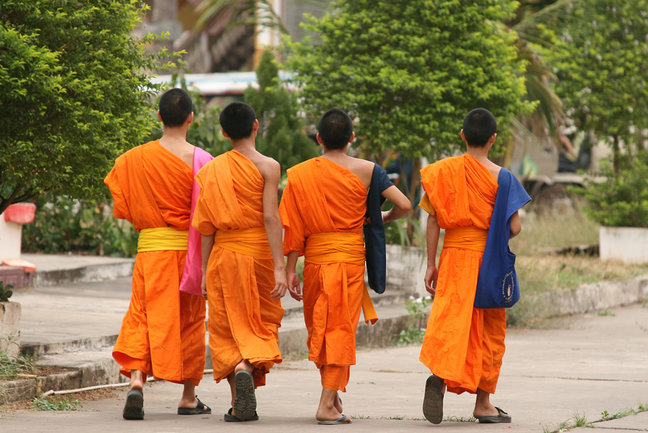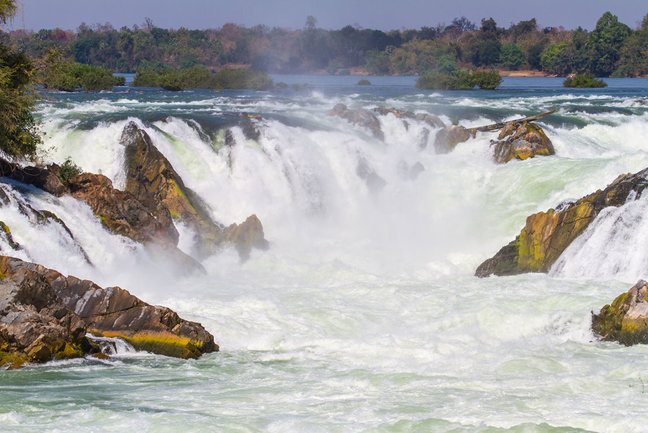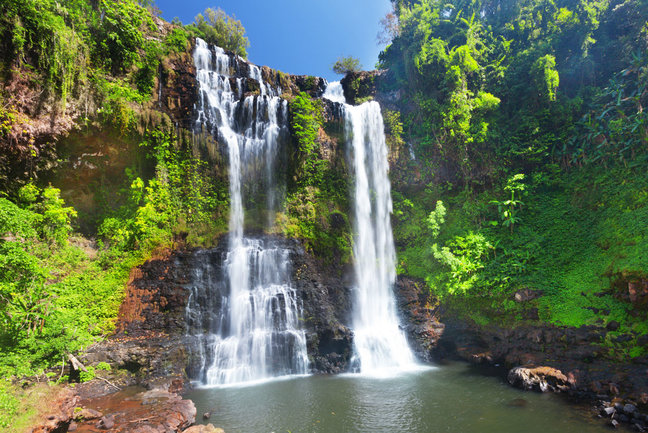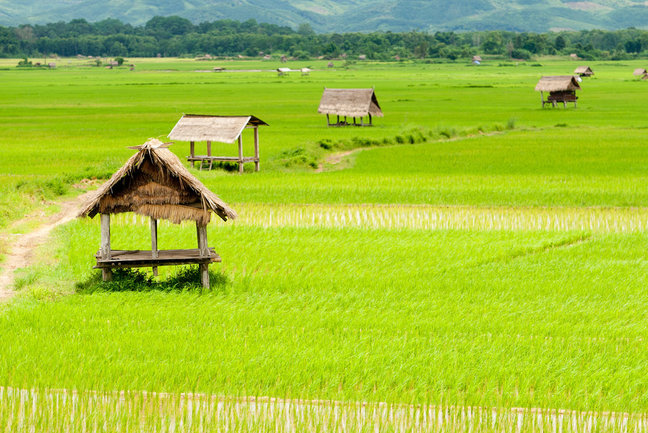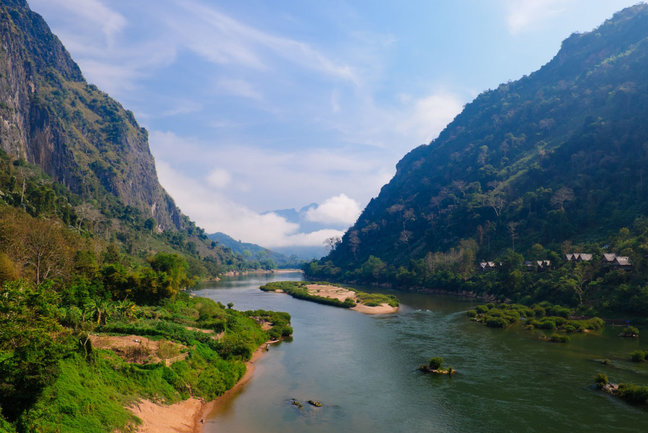Please enter your username and password to logon to the member pages

CLASSIC LAOS GRAND TOUR
CLASSIC LAOS GRAND TOUR Overview
Classic Laos Grand Tour Journey through a land of cultural traditions, natural environment, and imposing historical relics. Witness centuries old temples with visits to Kuang Si Waterfall and local villages in the area.Stop at limestone caves along the Mekong River before heading off to the capital city. Visit the numerous traditional temples before heading off to Pakse’s coffee plantations and the stunning 4000 Islands inlet and the Bolaven plateau.
Best time to visit is during the dry season from November to March.
Touring style: Professional English speaking guide and driver on private basis
Day 1: Vientiane
Arrival in Vientiane, the capital city of Laos with its laid-back charm, tree-lined boulevards, interesting wats and colourful markets. Discover the city by touring different highlights, such as Pha That Luang, the most important national monument of Laos and a symbol of both the Buddhist religion and Lao sovereignty. Proceed to Ho Pha Keo, the former royal temple, Wat Si Saket and Patuxai, a monumental arch inspired by the Arc de Triomphe in Paris. Overnight in Vientiane.
Distance and journey time: 4 km, 15 mins
Day 2: Vientiane - Luang Prabang
Take a flight from Vientiane to Luang Prabang, a city known for its beautiful setting surrounded by mountains and relaxed atmosphere. Set between the Nam Khan and Mekong rivers, Luang Prabang is an enchanting town filled with historic temples and colonial style buildings. The entire town was declared a UNESCO World Heritage Site in 1995.
After check-in start exploring this fascinating town beginning with Wat Visoun (Wat Wisunalat), the oldest living temple in Luang Prabang. Visit the nearby Wat Aham before continuing to Wat Xieng Thong, the crowning jewel of all the monasteries and temples in typical Lao art style. From there, stroll down the main street (Wat Street) of Luang Prabang. If time permits, stop at some of the many temples that line its sides, including Wat Sibounheuang, Wat Si Moungkhoun, Wat Sop and Wat Sene. In the evening, climb the hillside stairs to the small temples atop Phou Si and enjoy a beautiful view over the temples and river.
Overnight in Luang Prabang
Distance and journey time:
Luang Prabang Airport to city centre: 4 km, 15 mins
Day 3: Luang Prabang
Begin the day with a visit to a local market and observe the bustle and activity of the early morning. Visit of the National Museum, formally known as the “Royal Palace”, a modest but graceful building which has been preserved as it was when the royal family last lived here. After having visited Wat Mai, a typical Lao style temple, drive by vehicle to the Kuang Si Waterfalls. This multi-tier waterfall tumbles over limestone formations into a series of turquoise pools. Enjoy swimming in the clear water or just relax in the natural environment. On the way back take the chance to visit Ban Tha Pene, a traditional weaving Khmu village. Overnight in Luang Prabang.>/p>
Day 4: Luang Prabang – Oudomxai
Today’s journey will lead you through the scenic Laos countryside from Luang Prabang to Oudomxai (Muang Xai). Take the chance on this enjoyable trip to visit The Tad Lak Sip-et waterfall, which cascades in a narrow stream over a limestone cliff. Visit the minority village of Ban Song Cha and get some insight into the rural lifestyle before arrival and overnight in Oudomxai.
Distance and journey time: 193 km, 4 hrs
Day 5: Oudomxai - Muang Sing
Travel from Oudomxai (Muang Xai) to Muang Sing, a scenic town, home to the Thai Lue people and draws all kind of locals from around the region for trading. Tour the town, by visiting the local market, the main Buddhist Temples, Wat Xieng Jai and Wat Nam Kaew Luang. Wander out into the countryside and take the opportunity to visit some of the different minority villages in the area. Overnight in Muang Sing.
Distance and journey time: 175 km, 5 hrs
Day 6: Muang Sing - Luang Nam Tha
After an enjoyable trip from Muang Sing to Luang Nam Tha, along winding roads through beautiful tropical forests, passing hill tribe villages en route, begin to discover the provincial capital of the Luang Nam Tha Province. This rapidly expanding town plays an important role as a centre for commerce between China, Thailand, and Laos.
Begin the sightseeing program by visiting the local market and Phoum Pouk Pagoda, first built in 1624, now in ruins after the Indochina War. Continue to the Luang Nam Tha Museum for an overview of the different ethnic minorities that inhabit the area. In the afternoon, explore the many minority villages in the area, including a Black Tai village. These tribes are known for their silk production and weaving. Continue to a 200-year-old Lenten village, whose inhabitants are renown for paper making and indigo dyes; a Khmu village known for basketry and water gourds; and a Hmong village which has a selection of handicrafts from surrounding ethnic groups. Overnight in Luang Nam Tha.
Distance and journey time: 60 km, 2 hrs
Day 7: Luang Nam Tha - Nong Khiaw
The first part of the journey from Luang Nam Tha to Nong Khiaw will offer the opportunity for sightseeing in Ban Na Yang. After proceeding southwards through the scenic countryside, visit the village of the Thai Lue known for their cotton weaving skills. Arrival and overnight in Nong Khiaw.
Day 8: Nong Khiaw - Luang Prabang
Another exciting day will begin with a boat trip from Nong Khiaw to Luang Prabang. Travel by car to a dam from where you will catch the boat. Cruise downstream on the Mekong River, passing steep limestone cliffs and enjoy a wonderful view over the Mekong and the Nam Ou rivers, home to the Tham Pak Ou Caves. These extraordinary caves are filled with Buddha images, of every style and material imaginable. On the return journey, stop at Ban Xang Hai village, famous for the production of láo-láo, the local rice wine whisky. Overnight in Luang Prabang.
Distance and journey time:
Nong Khiaw – Nam Ou dam by car (70 km): 2.5 hrs
Nam Ou dam – Luang Prabang by boat (50 km): 2 hrs
Day 9: Luang Prabang - Vang Vieng
Travel from Luang Prabang to Vang Vieng visiting local villages on the way. Another highlight of the day is the visit of the Tham Xang Cave, also called Elephant Cave. It contains a few Buddha images, footprints. and elephant shaped stalactites which gave the cave its name. Overnight in Vang Vieng.
Distance and journey time: 230 km, 5 hrs
Day 10: Vang Vieng – Vientiane
Begin the day by visiting the extraordinary Tam-Chang Cave which in the past was used as a bunker against the Chinese and is nowadays a place to admire the stunning stalactites and stalagmites. On the route to Vientiane, stop for a visit to the Talat fish market in Huay Mor and continue to Vang Xang, an 11th-century Buddhist archaeological site where primitive Buddha images are carved on the cliff. Overnight in Vientiane.
Distance and journey time: 160 km, 4 hrs
Day 11: Vientiane - Pakse - Tad Lo- Champasak
Take a flight from Vientiane to Pakse and continue east across the Bolaven Plateau, a fertile coffee and tea growing area, rich in ethnic groups, predominantly Laven. The journey through the pleasantly cool climate will include several visits to different waterfalls in the region and gives the opportunity to admire and enjoy the beautiful natural surroundings. Along the way between Pakse and Paksong, on the western edge of the plateau, visit the impressing Tad E-tu waterfall, the Tad Fane waterfall, and the highest in Champasak Province and also the Tad Yuang waterfall. Afterwards head north towards Salavan with a stop at minority villages and visits to Tad Lo and Tad Hang waterfalls. Overnight in Champasak
Distance and journey time:
Pakse to Tad Lo: 120 km, 1.30 hrs
Day 12: Champasak to Don Khong
Visit Vat Phou Champasak, one of the best-preserved examples of major Khmer architecture, more than 200 years older than Angkor Wat itself. Continue southwards towards Don Khong. Overnight in Don Khong.
Distance and journey time:
Champasak to Don Khong: 100 km, 2 hrs
Day 13: Don Khong
Take a boat from Don Khong to Don Det island and Don Khone. The islands are connected by a former railway bridge which stopped operating in 1945. The larger island Don Det is famous throughout Laos for the cultivation of coconut, bamboo, and kapok.
Take the chance to visit Ban Khon village, the main village on Don Khone with several old French villas and continue to Taat Somphamit (Li Phi Falls), a raging set of rapids at the western end of Don Khone. Overnight in Don Khong.
Day 14: Don Khong to Pakse
After crossing the Mekong by ferry visit the miraculous Khone Phapheng, the largest waterfall in Southeast Asia and one of the most impressive sites in the area. Here, the entire Mekong with all its force cascades down curving stone outcroppings and tints the massive stones reflecting beautiful rainbows. After heading north the next and final destination is Pakse. Founded by the French in 1905 as an administrative post, the capital of Champasak Province is a relatively new town at the confluence of the Mekong and Se Don rivers. Spend the day exploring the highlights of the town, including the Central Market, Wat Luang, Wat Tham Fai, the Champasak Historical Heritage Museum and the trading post of Ban Muang Kao, and the weaving village of Ban Saphai. Overnight in Pakse.
Distance and journey time: 130 km, 2 hrs
Day 15: Departure
Transfer to the airport for departure

